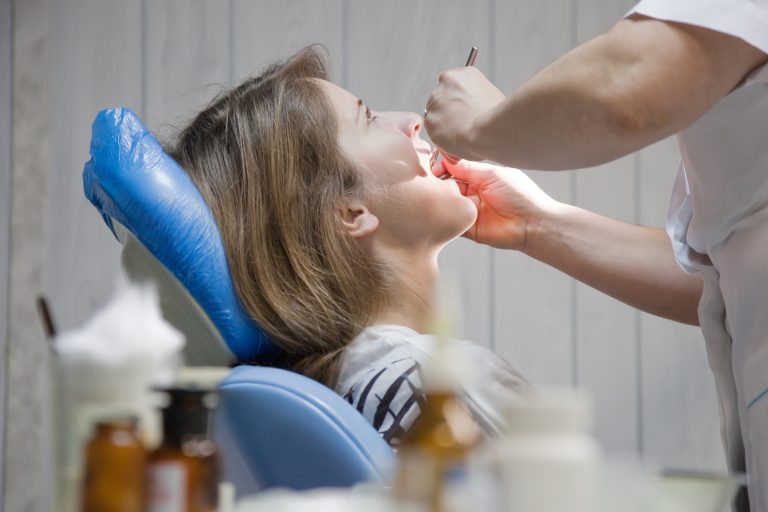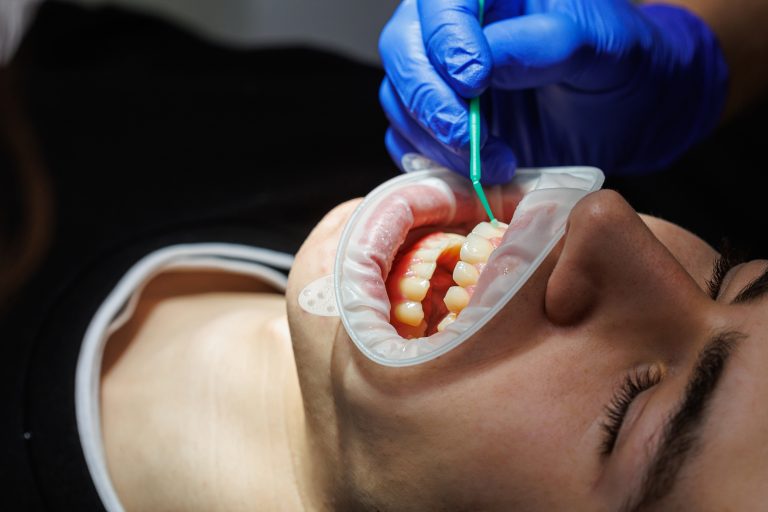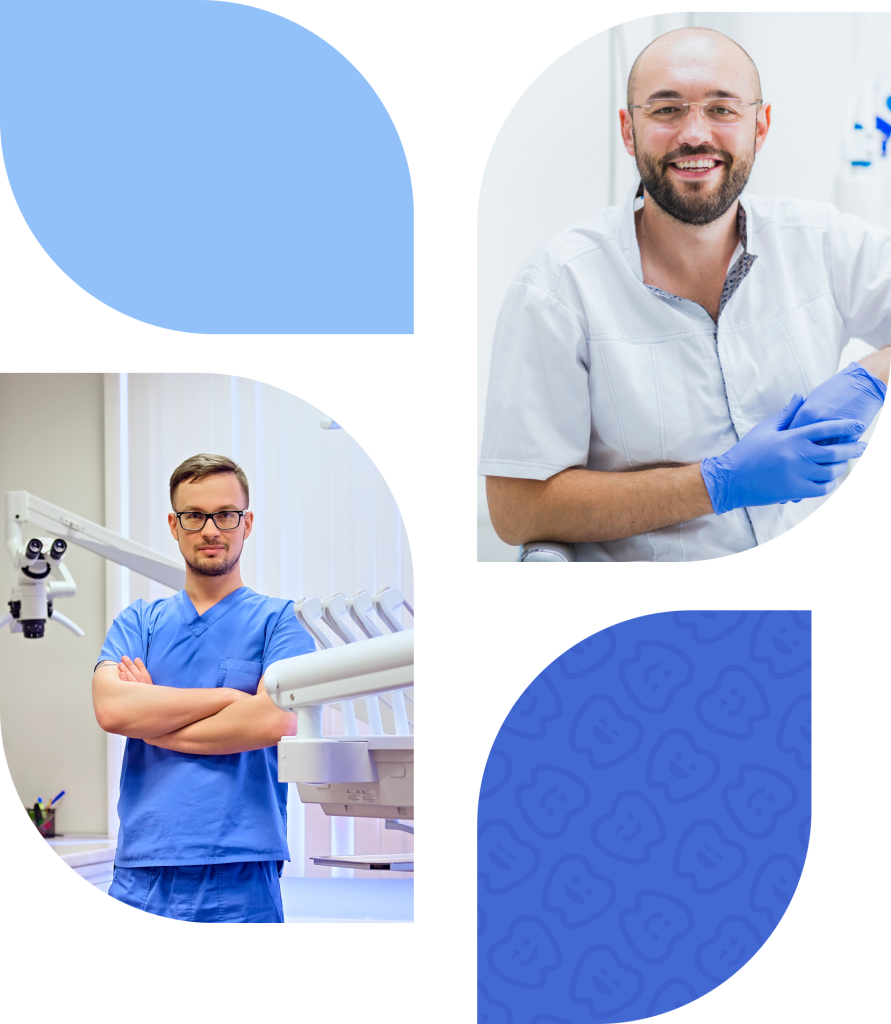

Flap Operasyonu Nedir?
Flap operasyonu, periodontal hastalıkların ileri evrelerinde uygulanan cerrahi bir tedavi yöntemidir. Diş eti çekilmesi, kemik kaybı ve derin diş eti cepleri gibi durumlarda etkili olan prosedür, ağız içindeki iltihaplı dokuların uzaklaştırılması ve kemik yüzeyinin temizlenmesini amaçlar.
Flap ameliyatı, diş eti dokusunun kontrollü şekilde kesilerek kaldırılması ve dişin çevresindeki kök yüzeyleriyle altındaki kemiğin görünür hâle getirilmesiyle gerçekleştirilir. Bu yöntemle diş taşlarının tamamen temizlenmesi ve iltihaplı dokunun ortadan kaldırılması sağlanır. Cerrahi müdahale sonrasında diş etleri eski pozisyonuna getirilerek dikiş atılır ve bölge iyileşmeye bırakılır. Flap operasyonu, iltihaplı dokuların temizlenmesini ve diş etinin sağlıklı hâle getirilmesini hedefler.
Flap Operasyonu Ne İçin Yapılır?
Flap operasyonunun uygulanma amacı; periodontal cep derinliklerinin azaltılması, enfekte olmuş dokuların uzaklaştırılması ve ağız sağlığının yeniden sağlanmasıdır. Geleneksel diş eti temizliği yöntemleriyle ulaşılması zor olan derin bölgelerin doğrudan görülebilmesini ve etkili bir şekilde temizlenmesini sağlar. Diş eti hastalıkları, zamanla kemik dokusunu da etkileyerek dişlerin kaybedilmesine neden olabilir. Flap operasyonu bu süreci durdurmak veya yavaşlatmak için tercih edilir.
Özellikle ileri düzey periodontitis vakalarında, diş eti ceplerinin içindeki sertleşmiş plakların ve bakterilerin tamamen çıkarılması ancak bu yöntemle mümkün hâle gelir. Diş taşı temizliğiyle yeterince tedavi edilemeyen durumlarda flap cerrahisiyle daha etkin bir temizlik yapılabilir. Flap operasyonu; ağız içinde sağlıksız doku birikimini önlemek, diş etlerinin dişe daha sıkı şekilde tutunmasını sağlamak ve ağız bakımını kolaylaştırmak amacıyla uygulanır.
Flap Operasyonu Nasıl Yapılır?
Flap operasyonu, lokal anestezi altında gerçekleştirilen kontrollü bir cerrahi işlemdir. Tedaviye başlamadan önce, hastanın diş eti durumu detaylı olarak değerlendirilir ve radyolojik görüntüleme yöntemleriyle destek alınır. İşlem sırasında diş eti dokusu cerrahi olarak kesilir ve kök yüzeyine erişim sağlamak amacıyla dikkatlice kaldırılır. Bu aşamada diş köklerinin yüzeyi ve çevresindeki kemik dokusu tamamen görünür hâle gelir.
Ardından diş taşları, birikmiş bakteri plakları ve iltihaplı yumuşak doku temizlenir. Diş etlerinin altında biriken hastalıklı dokular uzaklaştırıldıktan sonra gerekirse kemik yüzeyinde düzeltmeler yapılır. İşlem tamamlandıktan sonra diş eti eski pozisyonuna getirilerek dikiş atılır. Dikişler genellikle birkaç gün ya da bir hafta içinde alınır. Flap operasyonu sırasında kullanılan teknikler ve yapılacak müdahalenin kapsamı, hastalığın şiddetine ve etkilenen bölgenin büyüklüğüne bağlı olarak değişiklik gösterebilir. İşlem tamamlandıktan sonra hastaya operasyon sonrası bakım talimatları verilir ve düzenli kontroller planlanır.
Flap Tedavisi Aşamaları
Flap tedavisi, belirli protokollere göre planlanan birden fazla aşamadan oluşur. İlk aşama, hastanın detaylı olarak muayene edilmesi ve diş eti sağlığının değerlendirilmesidir. Röntgen ve diğer görüntüleme yöntemleriyle kemik kaybı, cep derinlikleri ve dişlerin çevresindeki doku durumu analiz edilir. Ardından ağız hijyeninin iyileştirilmesi amacıyla profesyonel diş taşı temizliği yapılır. Flap operasyonuna geçmeden önce hastanın sistemik durumu da dikkate alınarak gerektiğinde medikal hazırlıklar yapılır.
Cerrahi müdahale sırasında diş etine kesi atılır ve kök yüzeyleri ortaya çıkarılır. Derin temizlik işlemi uygulanır, enfekte olmuş dokular ve sertleşmiş bakteri tabakaları uzaklaştırılır. Gerekirse kemik düzleştirme işlemi de yapılabilir. İşlem sonunda diş eti dokusu yeniden yerine yerleştirilir ve dikiş atılır.
Hastaya operasyon sonrası dönemde nelere dikkat etmesi gerektiği anlatılır ve kontrol günleri planlanır. Flap tedavisinin başarısı, cerrahinin etkinliği kadar hastanın tedavi sonrası dönemde ağız bakımına gösterdiği özenle de doğrudan ilişkilidir.
Flap diş tekniği, periodontal dokuların altında bulunan diş kök yüzeylerine ulaşmayı kolaylaştırmak için diş eti dokusunun bir kısmının kaldırılması veya çıkarılmasıyla gerçekleştirilir. Bu işlem, diş eti altında yer alan plak, tartar ve enfekte dokuların temizlenmesi, diş kökü yüzeylerinin düzeltilmesi veya tedavi edilmesi amacıyla yapılır. Daha sonra, temizlenen veya tedavi edilen bölgeye yeniden diş eti dokusu yerleştirilir ve dikilir.
Bu teknik, periodontal hastalıkların tedavisinde ve diş implantları gibi işlemlerde kullanılabilir. Flap diş işlemi, periodontal cerrahi alanında uzmanlaşmış diş hekimleri tarafından gerçekleştirilir ve hastanın tedavi planına ve durumuna bağlı olarak farklı varyasyonlarda uygulanabilir.
Anestezi:
İşlem başlamadan önce, hastaya lokal anestezi uygulanır. Bu, işlemin ağrısız bir şekilde yapılmasını sağlar.
Flap Oluşturma:
İlk adım, periodontal hastalığın tedavi edileceği diş eti dokusunun belirlenmesidir. Sonrasında, bu alandaki diş eti dokusu, periodontal cebi açığa çıkarmak için yavaşça kaldırılır veya kesilir. Bu kaldırılan doku, “flap” olarak adlandırılır. Flap, diş eti ve periodontal cebin altındaki diş kökü ve çevresindeki yapıları ortaya çıkarmak için kullanılır.
Temizleme ve Düzeltme:
Flap açıldıktan sonra, diş hekimi periodontal cebi, diş kökü yüzeylerini ve çevre dokuları detaylı bir şekilde inceleyebilir. Plak, tartar ve enfekte doku gibi istenmeyen materyaller bu aşamada temizlenir. Diş kökü yüzeylerindeki düzensizlikler düzeltilir veya tedavi edilir.
Yeniden Şekillendirme ve Tedavi:
Gerekli durumlarda, diş eti dokusu yeniden şekillendirilebilir veya düzeltilen diş kökü yüzeylerine uygulanan özel tedavi yöntemleriyle iyileştirilebilir. Bunlar arasında diş eti greftleri veya kemik greftleri gibi prosedürler bulunabilir.
Flap Yerine Dikme:
İşlem tamamlandığında, flap kaldırıldığı yerin üzerine geri yerleştirilir ve diş eti dokusu, diş köküne sıkıca tutunabilmesi için dikişlerle kapatılır.
İyileşme Süreci:
Flap diş tekniğinin ardından, hastanın periodontal bölge iyileşme sürecine girer. Bu süreç boyunca, hastanın diş eti dokusu iyileşir ve diş eti çevresindeki sağlıklı dokular yeniden büyüyebilir.
Flap diş tekniği, periodontal hastalıkların tedavisinde ve diş implantlarının yerleştirilmesi gibi durumlarda başarılı sonuçlar elde etmek için yaygın olarak kullanılan bir yöntemdir. Ancak, her hasta ve durum farklı olduğundan, tedavi planı ve prosedürüne yönelik detaylar hastanın ihtiyaçlarına ve diş hekimi tarafından belirlenen spesifik duruma göre değişebilir. Bu nedenle, flap diş tekniğinin uygulanması öncesinde, diş hekiminizle detaylı bir şekilde konuşmanız önemlidir.
Flap Ameliyatı Sonrası Ağız Bakımı
Flap ameliyatı sonrasında ağız bakımına gösterilecek özen, iyileşme sürecinin hızlı ve sağlıklı ilerlemesi açısından önemlidir. İşlemden sonraki ilk 8 saat boyunca tükürülmemesi ve ağız çalkalanmaması önerilir. Bu sayede ameliyat bölgesinde oluşan pıhtı korunmuş olur. Ağız hijyenine dikkat edilmesi gereken bu dönemde, cerrahi bölgeye doğrudan temas ettirmemek şartıyla diğer dişlerin nazik şekilde fırçalanması gerekir.
Diş hekiminin reçete ettiği gargara, ağrı kesici ve antibiyotik gibi ilaçlar düzenli olarak kullanılmalıdır. Yumuşak gıdalarla beslenmek, aşırı sıcak ya da soğuk yiyeceklerden uzak durmak gerekir. İyileşmeyi olumsuz etkileyebileceğinden sigara kullanımı önerilmez.
İlk birkaç gün boyunca diş eti bölgesinde şişlik, hafif kanama ya da hassasiyet oluşması normaldir. Kontrollü bir iyileşme için kontroller aksatılmamalı ve dikişler zamanında alınmalıdır. Dikişler alınana kadar bölgeye sert müdahalelerden kaçınılmalı ve hekim önerisi dışında herhangi bir ağız içi uygulama yapılmamalıdır.
Flap Operasyonu Hangi Durumlarda Yapılır?
Flap operasyonu, diş eti hastalıklarının ilerlemiş evrelerinde, geleneksel tedavi yöntemlerinin yetersiz kaldığı durumlarda uygulanır. Özellikle derin diş eti cepleri, kök yüzeyinde sertleşmiş diş taşları, kemik kaybı ve iltihaplı dokuların varlığı flap operasyonunun en sık uygulama nedenlerindendir. Diş taşı temizliği ya da küretaj işlemleri ile ulaşılması güç bölgelerin doğrudan görülmesi ve etkili temizlenmesi ancak bu yöntemle mümkündür.
Ayrıca diş eti çekilmesi nedeniyle diş köklerinin açığa çıkması ve bu alanların enfekte olması, flap operasyonunu gerektirebilir. Periodontal hastalıkların ilerlemesini durdurmak, kemik dokunun korunmasını sağlamak ve ağız içi bakımın daha sağlıklı yapılabilmesi amacıyla flap operasyonu tercih edilebilir.
Bazı vakalarda implant öncesi cerrahi hazırlık sürecinde de flap operasyonuna başvurulabilir. Estetik bölgedeki diş eti konturlarının düzenlenmesi gereken durumlarda ya da yumuşak doku cerrahisine ihtiyaç duyulan kompleks vakalarda bu yöntemden faydalanılabilir. Flap operasyonu, tedavi edici ve önleyici bir cerrahi uygulama olarak değerlendirilebilir.
Flap Operasyonu Kaç Günde İyileşir?
Flap operasyonunun iyileşme süresi; hastanın genel sağlık durumu, ağız hijyenine gösterdiği özen ve cerrahi müdahalenin kapsamına bağlı olarak değişebilir. Genellikle operasyon sonrası ilk birkaç gün içinde şişlik ve hassasiyet azalmaya başlar. Dikişler genellikle 7 ila 10 gün içinde alınır. İlk hafta sonunda bölgedeki iyileşme gözle görülür şekilde ilerler. Tam iyileşmenin sağlanması ise yaklaşık 3 ila 4 haftalık bir süreci kapsar.
Ağız hijyeninin ihmal edilmesi, sigara kullanımı ya da ilaçların düzensiz kullanımı iyileşme süresini uzatabilir. İyileşme süreci boyunca sert yiyeceklerden kaçınılmalı, bölgeye travma yaratacak hareketlerden uzak durulmalıdır. Hekimin önerdiği kontrollere düzenli katılım, iyileşme sürecinin takibi açısından önemlidir. İyileşme tamamlandığında diş eti sağlıklı, pembe ve sıkı bir görünüme kavuşur. Hasta ise ağız bakımını daha rahat bir şekilde sürdürebilir.
Flap Tedavisi Fiyatları
Flap tedavisinin fiyatları; uygulanacak cerrahi işlemin kapsamına, bölgedeki hasarın boyutuna ve tedavinin yapıldığı kliniğin donanımına göre değişkenlik gösterebilir. Her hastanın ağız yapısı ve ihtiyaç duyduğu müdahale farklı olduğu için standart bir ücretlendirme yapılması mümkün değildir.
Tedavi öncesinde yapılacak muayene ve radyolojik değerlendirmeler doğrultusunda kişiye özel bir tedavi planı oluşturulur. Plan doğrultusunda yapılacak cerrahi işlemlerin türü, seans sayısı ve gerekli bakım prosedürleri dikkate alınarak maliyet belirlenir. Operasyonun yapıldığı şehir, kliniğin bulunduğu bölge ve hekimin uzmanlık düzeyi de fiyatlandırmada rol oynar. Bazı vakalarda ek tedaviler ya da ileri cerrahi müdahaleler gerekebileceğinden fiyat bu unsurlara göre yeniden şekillenebilir.
Flap operasyonunun başarısı; uygulamanın doğru bir planlama ve profesyonel bir yaklaşımla gerçekleştirilmesine bağlıdır. Bu nedenle tedavi süreci başlamadan önce detaylı bir değerlendirme yapılmalı ve hasta bilgilendirilmelidir. Tedavi kalitesinin ön planda tutulduğu durumlarda uzun vadeli sağlıklı sonuçlar elde edilebilir.
Bize Mesaj Gönderin
Randevu Saatleri
Pazartesi – Cuma: 08:00 – 18:00
Pazar günleri ve resmi tatillerde kapalıyız.
İletişim
Yeni Mahallesi İntizam Sokak No:7 Pendik / İstanbul
0216 390 95 80
0505 372 09 26
Hasta Yorumları
Kliniğimizde, sıcak bir karşılama, şeffaf iletişim ve üstün hizmet kalitesiyle, diş sağlığı konusundaki tüm ihtiyaçlarınıza cevap vermeye hazırız.
Kaplamalarımla alakalı gitmiştim kaplamalarımın altında kistler oluşmuştu. İmplant takıldı şuan çok memnunum .Esra hanımdan önce 3 -4 tane dişçiye gittim ama hep problemler çıkardılar kaplamayı takarken dişlerimi kökten kırdılar. En son Esra hanımı önerdiler gittim ve çok memnun kaldım . Eli çok hafif ve işi bilen bir hekim Kanal tedavisi ile dişlerimin tamamını kurtardı. yakınlarıma,aileme tavsiye ettim . Ailemden de gidenler var.

TR

TR
Sıkça Sorulan Sorular: “Flap“
Flap işlemi genellikle lokal anestezi altında yapılır, bu nedenle işlem sırasında ağrı hissedilmez. İşlem sonrası hafif rahatsızlık olabilir ancak bu genellikle yönetilebilir düzeydedir.
Flap işlemi, tedavinin karmaşıklığına bağlı olarak değişebilir. Genellikle işlem bir saat ile birkaç saat arasında sürebilir.
Flap işlemi sonrası diş hekiminizin verdiği talimatları dikkatlice takip etmelisiniz. Genellikle yemek yeme ve diğer aktivitelerde birkaç gün boyunca dikkatli olmanız önerilir.
Flap işlemi genellikle implant uygulamalarında, periodontal hastalıklarda veya diğer çeşitli diş ve diş eti sorunlarında kullanılabilir.
